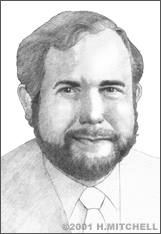Stephen Benton
Stephen A. Benton was the Rudge and Nancy Allen Professor of Media Arts and Sciences at the Massachusetts Institute of Technology (MIT) and director of the MIT Center of Advanced Visual Studies (CAVS). He was known as a living legend in the field of modern holography, having authored a variety of articles, been awarded a number of patents, and contributed significant research to the field.
Born in San Francisco in 1941, Benton graduated as an electrical engineer from MIT in 1963. At MIT, he worked with Professor Harold Edgerton in his famous "Strobe Lab." He earned a doctoral degree in applied physics at Harvard University five years later, staying there as an assistant professor of optical physics until 1973.
While at Harvard, Benton's first great invention was his 1968 creation of the "White Light Transmission Rainbow" hologram, which is also called "Benton Hologram." The holograms, which are often seen on magazine covers and credit cards, use a technique that sacrifices the vertical parallax of the image in favor of a Rainbow spectral coloration that is projected into the viewer's visual space.
As a student, Benton became involved with the Polaroid Corporation research laboratory, where he was later named Chief Researcher. Benton became affiliated with MIT's Center for Advanced Visual Studies (CAVS) in 1977, when he joined the team of artists, scientists, and engineers who collaborated with former CAVS director Otto Piene on the Centerbeam project, a large-scale steam laser, laser, and optical project.
In 1982, Benton joined the faculty at MIT to become a founding member of the Media Laboratory and to establish a teaching and research program in high-quality three-dimensional imaging applied to the human/computer interface. He and his students worked on creating the world's first holographic video system.
This research, focused on the conjunction of holographic and computer technologies, have alighted "Alcove Holograms," "Ultragrams," and a laboratory prototype to which electronic holographic images can be computerized and shown in real-time by means of an opto-acoustic modulator and a system of revolving mirrors. This research may lead to holographic video systems in the future.
Benton earned 14 patents and a number of awards for his work. In 1995, Benton's contributions to the art and science of holography were recognized with the "Vinci of Excellence" award of the International Science for Art competition. He belonged to several optical societies, New York's Museum of Holography, and Rochester's Museum of Photography at Georges Eastman's House's boards of trustees.
Benton died on November 9, 2003 at the age of 61.


